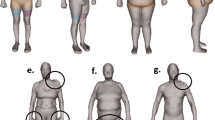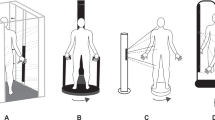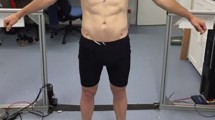Abstract
Objective
Three-dimensional optical (3DO) imaging devices for acquiring anthropometric measurements are proliferating in healthcare facilities, although applicability in young children has not been evaluated; small body size and movement may limit device accuracy. The current study aim was to critically test three commercial 3DO devices in young children.
Methods
The number of successful scans and circumference measurements at six anatomic sites were quantified with the 3DO devices in 64 children, ages 5–8 years. Of the scans available for processing, 3DO and flexible tape-measure measurements made by a trained anthropometrist were compared.
Results
Sixty of 181 scans (33.1%) could not be processed for technical reasons. Of processed scans, mean 3DO-tape circumference differences tended to be small (~1–9%) and varied across systems; correlations and bias estimates also varied in strength across anatomic sites and systems (e.g., regression R2s, 0.54–0.97, all p < 0.01). Overall findings differed across devices; best results were for a multi-camera stationary system and less so for two rotating single- or dual-camera systems.
Conclusions
Available 3DO devices for quantifying anthropometric dimensions in adults vary in applicability in young children according to instrument design. These findings suggest the need for 3DO devices designed specifically for small and/or young children.
This is a preview of subscription content, access via your institution
Access options
Subscribe to this journal
Receive 12 print issues and online access
$259.00 per year
only $21.58 per issue
Buy this article
- Purchase on Springer Link
- Instant access to full article PDF
Prices may be subject to local taxes which are calculated during checkout




Similar content being viewed by others
References
Janssen I, Leblanc AG. Systematic review of the health benefits of physical activity and fitness in school-aged children and youth. Int J Behav Nutr Phys Act. 2010;7:40.
Loeffler-Wirth H, Vogel M, Kirsten T, Glock F, Poulain T, Korner A, et al. Longitudinal anthropometry of children and adolescents using 3D-body scanning. PLoS ONE. 2018;13:e0203628.
Skinner AC, Ravanbakht SN, Skelton JA, Perrin EM, Armstrong SC. Prevalence of obesity and severe obesity in US children, 1999-2016. Pediatrics. 2018;141:e20173459.
Lifshitz F. Obesity in children. J Clin Res Pediatr Endocrinol. 2008;1:53–60.
Cameron N. The measurement of human growth. London: Croom Helm; 1984.
Madden AM, Smith S. Body composition and morphological assessment of nutritional status in adults: a review of anthropometric variables. J Hum Nutr Diet. 2016;29:7–25.
Ulijaszek SJ, Mascie-Taylor CGN. Anthropometry: the individual and the population, Cambridge: Cambridge University Press; 1994.
Frisancho AR. Anthropometric standards for the assessment of growth and nutritional status. Ann Arbor: University of Michigan Press; 1990.
Roche AF, Mukherjee D, Guo SM, Moore WM. Head circumference reference data: birth to 18 years. Pediatrics. 1987;75:706–12.
Din N, Fan B, Kazemi L, Ng B. Validation of body composition measures from forearm and lateral distal femur scans of children [abstract]. J Clin Densitom. 2018;21:32.
Kalkwarf HJ, Zemel BS, Gilsanz V, Lappe JM, Horlick M, Oberfield S, et al. The bone mineral density in childhood study: bone mineral content and density according to age, sex, and race. J Clin Endocrinol Metab. 2007;92:2087–99.
Kelly TL, Wilson KE, Heymsfield SB. Dual energy X-Ray absorptiometry body composition reference values from NHANES. PLoS ONE. 2009;4:e7038.
Shepherd JA, Wang L, Fan B, Gilsanz V, Kalkwarf HJ, Lappe J, et al. Optimal monitoring time interval between DXA measures in children. J Bone Miner Res. 2011;26:2745–52.
Kennedy S, Hwaung P, Kelly N, Liu YE, Sobhiyeh S, Heo M, et al. Optical imaging technology for body size and shape analysis: evaluation of a system designed for personal use. Eur J Clin Nutr. 2020;74:920–9.
Tinsley GM, Moore ML, Benavides ML, Dellinger JR, Adamson BT. 3-Dimensional optical scanning for body composition assessment: a 4-component model comparison of four commercially available scanners. Clin Nutr. 2020;39:3160–7.
Wong MC, Ng BK, Kennedy SF, Hwaung P, Liu EY, Kelly NN, et al. Children and adolescents’ anthropometrics body composition from 3-D optical surface scans. Obesity. 2019;27:1738–49.
Bourgeois B, Ng BK, Latimer D, Stannard CR, Romeo L, Li X, et al. Clinically applicable optical imaging technology for body size and shape analysis: comparison of systems differing in design. Eur J Clin Nutr. 2017;71:1329–35.
Ng BK, Hinton BJ, Fan B, Kanaya AM, Shepherd JA. Clinical anthropometrics and body composition from 3D whole-body surface scans. Eur J Clin Nutr. 2016;70:1265–70.
Centers for Disease Control and Prevention (CDC), National Center for Health Statistics (NCHS). National Health and Nutrition Examination Survey (NHANES): anthropometry procedures manual. Hyattsville, MD: Centers for Disease Control and Prevention (CDC); 2007.
Heymsfield SB, Bourgeois B, Ng BK, Sommer MJ, Li X, Shepherd JA. Digital anthropometry: a critical review. Eur J Clin Nutr. 2018;72:680–7.
Acknowledgements
This work was partially supported by National Institutes of Health NORC Center Grants P30DK072476, Pennington/Louisiana, P30DK040561, Harvard, and R01DK109008, Shape UP! Adults; the Louisiana State University Biomedical Collaborative Research Program; and the National Science Foundation I-Corps program.
Author information
Authors and Affiliations
Contributions
Authors’ contributions to manuscript: SK, MW, JS, and SBH designed research; SK, BS, SS, MED, NK, and MW conducted research; JS and SBH provided essential materials; SK, BS, MW, JS, and SBH analyzed data; SK, BS, SS, MED, MW, JS, NK, and SBH wrote the paper; SK, BS, SS, MED, MW, JS, NK, and SBH had primary responsibility for final content.
Corresponding author
Ethics declarations
Conflict of interest
The authors declare no competing interests.
Additional information
Publisher’s note Springer Nature remains neutral with regard to jurisdictional claims in published maps and institutional affiliations.
Supplementary information
Rights and permissions
About this article
Cite this article
Kennedy, S., Smith, B., Sobhiyeh, S. et al. Digital anthropometric evaluation of young children: comparison to results acquired with conventional anthropometry. Eur J Clin Nutr 76, 251–260 (2022). https://doi.org/10.1038/s41430-021-00938-x
Received:
Revised:
Accepted:
Published:
Issue Date:
DOI: https://doi.org/10.1038/s41430-021-00938-x
This article is cited by
-
Machine learning-based obesity classification considering 3D body scanner measurements
Scientific Reports (2023)
-
Emergence of the adolescent obesity epidemic in the United States: five-decade visualization with humanoid avatars
International Journal of Obesity (2022)



